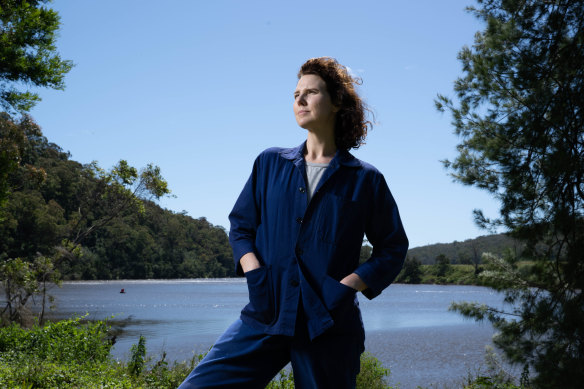Two tonnes of algae and oyster shells are a far cry from Arthur Boyd’s timeless paintings of the Shoalhaven River, but Kate Scardifield’s installation draws inspiration from the same landscape on the NSW South Coast.
Scardifield’s A weathering transforms the algae and oyster shells into a sculptural work, which she said “traces shifting states of materiality which unfold amongst large-scale steel frameworks and borrowed fishing nets from Greenwell Point”.
Artist Kate Scardifield created her sculptural installation with two tonnes of algae and oyster shells from farms along the Shoalhaven River.Credit:Janie Barrett
The sculpture is one of the artworks featured in the Inside, underground exhibition, part of Siteworks: From a Deep Valley at Bundanon, Boyd’s property on the Shoalhaven River that was gifted to the nation after his death.
Work by more than 25 artists and 15 scientists drawing on climate research and First Nations knowledge will feature in the festival, which unfolds across four summer weekends.
Bundanon chief executive Rachel Kent said the 1000-hectare property, situated within a high-risk fire and flood zone, is at the forefront of climate change and extreme weather patterns. In the past three years, the property experienced both fires and floods.
“Conversations around the environment, sustainability, and planetary care are central to Bundanon’s mission and they reflect Boyd’s stated intention to promote appreciation of our unique and precious landscape,” she said.
Climate change hangs heavily over Bundanon, which is part of the World Weather Network of artists that produce “weather reports” responding to the climate crisis.
Isadora Duncan’s Older than Bees is a wall in Bundanon’s new Art Museum with hundreds of beeswax blocks she inherited from an aunt and uncle who made and exhibited them more than a decade ago.
“The wall I have made will need to be broken apart to be taken down, so in that way it is a sacrifice, it is to exist only temporarily,” she said. “After this show, the wax will be melted down and stored, it will be just a material once more.“
Duncan said the artwork was illuminated with a light that is “a kind of fast or urgent sunrise and sunset”.
“The work for me is about family, about inheritance, cycles and responsibility, about materiality and fragility and communing with nature,” she said. “I believe these themes all resonate with the site at Bundanon.”
The scent of foliage and bark gathered from the grounds of Bundanon rise from a dye bath as lengths of fabric run through Rebecca Mayo’s Plant Sensibilia Machine.
Over several hours, the cloth takes up plant colour, revealing poetry and images as it spools through Mayo’s homemade dyeing machine.
“I wanted the process and the plants to be seen, smelt and felt in situ,” she said. “People are invited to step up to the machine and turn the handle. As they do this, a length of cloth, pre-printed with metal salts, is turned through a large, heated dye bath.”
Mayo designed the machine to deepen appreciation of the land and counter plant blindness, a term coined to describe a ”contemporary malaise where plants are little more than a backdrop for other life”.
“Bundanon is a sensorium,” she said. “The bush, despite the dramatic changes since white invasion, still lives and breathes. It offers colour, sound and smell – and quiet.”
The Morning Edition newsletter is our guide to the day’s most important and interesting stories, analysis and insights. Sign up here.
Most Viewed in Culture
From our partners
Source: Read Full Article
